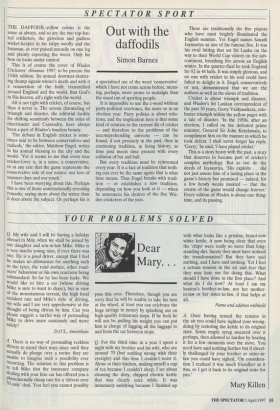SPECTATOR SPORT
Out with the daffodils
Simon Barnes
THE DAFFODIL-yellow colour is the same as always, and so are the two top-hat- ted cricketers, the gloveless and padless wicket-keeper in his stripy woolly and the batsman, as ever poised uneasily on one leg and plainly expecting the worst. Only his bow tie looks under control.
This is of course the cover of Wisden Cricketers' Almanac 1997, to be precise the 134th edition. Its annual doormat-shatter- ing thump signals winter's death and with it a reassertion of the faith, transmitted around England and the world, that God's in His heaven, all's right with the world.
All is not right with cricket, of course, but then it never is. The serene chronicling of triumph and disaster, the editorial facility for shifting seamlessly between the roles of cheerleader and Cassandra, have always been a part of Wisden's timeless beauty.
`The debate in English cricket is some- times said to be between conservatives and radicals,' the editor, Matthew Engel, writes in his annual blessing to the city and the world. 'Yet it seems to me that every true cricket-lover is, in a sense, a conservative, or at any rate that the game represents the conservative side of our nature: our love of summer days and our youth.'
I have been worrying about this. Perhaps this is one of those unintentionally revealing remarks, saying more about the writer than it does about the subject. Or perhaps his is a specialised use of the word 'conservative' which I have not come across before, mean- ing, perhaps, more prone to nostalgia than the usual run of sporting people.
It is impossible to use the c-word without party-political overtones, the more so in an election year. Party politics is about solu- tions, and the implication here is that some kind of solution to the current ills of cricket — and therefore to the problems of the uncomprehending universe — can be found, if not precisely in the past, then in continuing tradition, in living history, as time past meets time present with every collision of bat and ball.
But every tradition must be reinvented every year. It is a fact of tradition that noth- ing can ever be the same again: that is what time means. Thus Engel breaks with tradi- tion — or establishes a new tradition, depending on how you look at it — when he announces his choices of the five Wis- den cricketers of the year. These are traditionally the five players who have most brightly illuminated the English summer. Yet Engel names Sanath Jayasuriya as one of his famous five. It was his vivid hitting that set Sri Lanka on the way to their World Cup victory on the sub- continent, breathing fire across an English winter. In the quarter-final he took England for 82 in 44 balls. It was simply glorious, and no one with cricket in his soul could have failed to delight in it. Engel, conservatively or not, demonstrated that we are the authors as well as the slaves of tradition.
Cricket is about triumph and disaster, and Wisden's Sri Lankan correspondent of the past 30 years, Gerry Vaidyasekera, cele- brates triumph within the yellow pages with a tale of disaster. 'In the 1950s, after an election, I called on the defeated prime minister, General Sir John Kotelawala, to compliment him on the manner in which he took defeat. I shall never forget his reply. `Gerry,' he said, 'I have played cricket.'
This is a story heavy with the past, a story that deserves to become part of cricket's complex mythology. But so too do the deeds of Jayasuriya. 'His exploits . . . did not just assure him of a lasting place in the game's history but promised — indeed, for a few heady weeks insisted — that the course of the game would change forever.' Every edition of Wisden is about one thing: time, and its passing.


























































 Previous page
Previous page